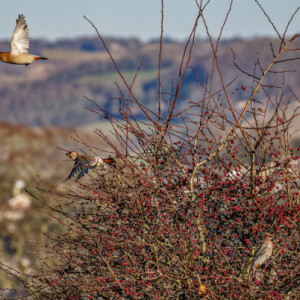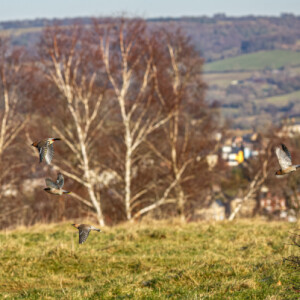The waxwings feeding avidly on Rodborough Common
Having missed seeing the waxwings yesterday, which returned after I’d left, I drove back to Rodborough Common today getting there by midday, on the off chance of seeing them. There has been an ‘irruption’, the technical name for a mass winter visit by waxwings from the European mainland, and they have been seen in many places. Local photographers have seen them for the last week and reports on birding websites reported sightings on the common above the Golden Valley.
I parked beside the common and immediately spotted a gathering of people in the distance close to a large copse. A man who had obviously just returned to his car from that direction told me that the waxwings were definitely around and occasionally visible where the group were gathered. I strolled over there enjoying the sunnier day than yesterday, with not even a breeze on the exposed tops of these Cotswold hills.
Enquiring of one of the gathered photographers he gave me the information that the waxwings were gathered in the copse. They were flying out in groups to feed on the hawthorn berries of some bushes on the open common, before returning hurriedly to the safer woodland.
Within ten minutes there was a call alerting the group of the birds imminent arrival and about twenty waxwings flew onto the nearby bush, and as described landed to feed on the berries and then quickly flew back. What a treat to be able to see them relatively closely and with the sun behind my back and the wonderful landscape above Stroud town down in the Frome valley as a backcloth.
I’ve blipped a close-up of one feeding as well as some ‘Extras’ of other views of them around the bushes and in flight.
I feel very privileged to have been able to see them once again. I saw some about six or seven years ago on the same common, but they don’t regularly come to this part of England as they normally stay in the eastern counties. Apparently these ‘irruptions’ occur when there has been a good breeding season so that their increased their numbers are too many for the amount of food generally available in their normal winter locations. Apparently once they have stripped the local berries they move on westwards as a flock to find new supplies. I wish them well.
I must admit that seeing them in person and then looking at these images the colours of their feathers are beautiful. In one or two photos I noticed there were some vivid blue patterns as well as the honey coloured tones the yellow, reds and white patches. Do have a look at the ‘Extras’ and admire them. Most of them are cropped images but they bear enlarging a bit.




Comments
Sign in or get an account to comment.


